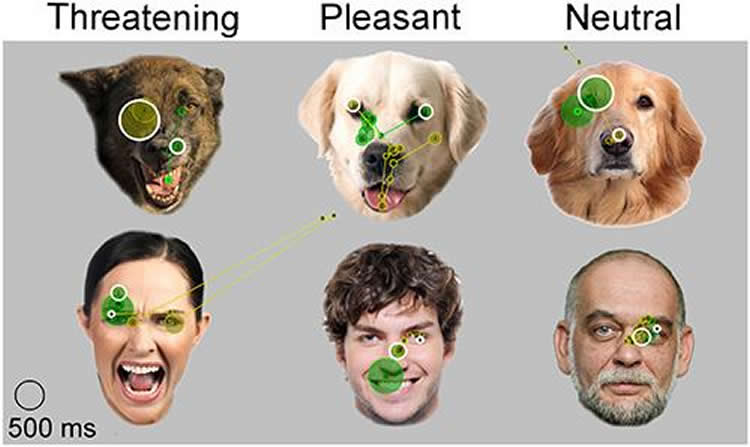A recent study from the University of Helsinki shows that the social gazing behavior of domestic dogs resembles that of humans: dogs view facial expressions systematically, preferring eyes. In addition, the facial expression alters their viewing behavior, especially in the face of threat. The study was published in the science journal PLOS ONE.
Threatening faces evoke unique responses in dogs
The study utilized eye gaze tracking to demonstrate how dogs view the emotional expressions of dog and human faces. Dogs looked first at the eye region and generally examined eyes longer than nose or mouth areas. Species-specific characteristics of certain expressions attracted their attention, for example the mouths of threatening dogs. However, dogs appeared to base their perception of facial expressions on the whole face.
Threatening faces evoked attentional bias, which may be based on an evolutionary adaptive mechanism: the sensitivity to detect and avoid threats represents a survival advantage. Interestingly, dogs’ viewing behavior was dependent on the depicted species: threatening conspecifics’ faces evoked longer looking but threatening human faces instead an avoidance response. Threatening signals carrying different biological validity are most likely processed via distinctive neurocognitive pathways.
“The tolerant behavior strategy of dogs toward humans may partially explain the results. Domestication may have equipped dogs with a sensitivity to detect the threat signals of humans and respond them with pronounced appeasement signals”, says researcher Sanni Somppi from the University of Helsinki.
Results provide support for Darwin’s views of animal emotions
This is the first evidence of emotion-related gaze patterns in non-primates. Already 150 years ago Charles Darwin proposed that the analogies in the form and function of human and non-human animal emotional expressions suggest shared evolutionary roots. Recent findings provide modern scientific support for Darwin’s old argument.

Exploring canine mind with dog-friendly methods
A total of 31 dogs of 13 different breeds attended the study. Prior the experiment the dogs were clicker-trained to stay still in front of a monitor without being commanded or restrained. Due to positive training approach, dogs were highly motivated to perform the task.
Funding: The study is part of the collaboration project of Faculties of Veterinary Medicine and Behavioural Science, University of Helsinki and Department of Neuroscience and Biomedical Engineering, Aalto University. Previously, the research group of professor Outi Vainio from the University of Helsinki has discovered that socially informative objects in images, as personally familiar faces and social interaction, attract dogs’ attention.
Source: Outi Vainio – University of Helsinki
Image Source: The image is credited to S. Somppi and 123rf/PLOS ONE
Original Research: Full open access research for “Dogs Evaluate Threatening Facial Expressions by Their Biological Validity – Evidence from Gazing Patterns” by Sanni Somppi, Heini Törnqvist, Miiamaaria V. Kujala, Laura Hänninen, Christina M. Krause, and Outi Vainio in PLOS ONE. Published online January 13 2016 doi:10.1371/journal.pone.0143047
Abstract
Dogs Evaluate Threatening Facial Expressions by Their Biological Validity – Evidence from Gazing Patterns
Appropriate response to companions’ emotional signals is important for all social creatures. The emotional expressions of humans and non-human animals have analogies in their form and function, suggesting shared evolutionary roots, but very little is known about how animals other than primates view and process facial expressions. In primates, threat-related facial expressions evoke exceptional viewing patterns compared with neutral or positive stimuli. Here, we explore if domestic dogs (Canis familiaris) have such an attentional bias toward threatening social stimuli and whether observed emotional expressions affect dogs’ gaze fixation distribution among the facial features (eyes, midface and mouth). We recorded the voluntary eye gaze of 31 domestic dogs during viewing of facial photographs of humans and dogs with three emotional expressions (threatening, pleasant and neutral). We found that dogs’ gaze fixations spread systematically among facial features. The distribution of fixations was altered by the seen expression, but eyes were the most probable targets of the first fixations and gathered longer looking durations than mouth regardless of the viewed expression. The examination of the inner facial features as a whole revealed more pronounced scanning differences among expressions. This suggests that dogs do not base their perception of facial expressions on the viewing of single structures, but the interpretation of the composition formed by eyes, midface and mouth. Dogs evaluated social threat rapidly and this evaluation led to attentional bias, which was dependent on the depicted species: threatening conspecifics’ faces evoked heightened attention but threatening human faces instead an avoidance response. We propose that threatening signals carrying differential biological validity are processed via distinctive neurocognitive pathways. Both of these mechanisms may have an adaptive significance for domestic dogs. The findings provide a novel perspective on understanding the processing of emotional expressions and sensitivity to social threat in non-primates.
“Dogs Evaluate Threatening Facial Expressions by Their Biological Validity – Evidence from Gazing Patterns” by Sanni Somppi, Heini Törnqvist, Miiamaaria V. Kujala, Laura Hänninen, Christina M. Krause, and Outi Vainio in PLOS ONE. Published online January 13 2016 doi:10.1371/journal.pone.0143047






